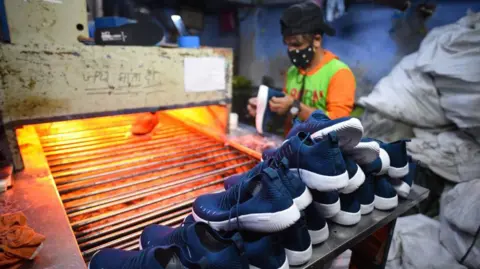The Indian footwear industry is currently undergoing a significant transformation as it attracts foreign investments while grappling with its domestic dynamics. A notable example is the recent investment from Taiwan’s Hong Fu Industrial Group, the world’s second-largest sneaker manufacturer, known for producing approximately 200 million pairs of shoes annually for prestigious brands such as Nike, Adidas, and Converse. This major investment includes the establishment of a colossal manufacturing facility in Panapakkam, Tamil Nadu. Once completed, this operation is projected to yield 25 million pairs of shoes each year and create employment for approximately 25,000 workers. The entrance of a company of such global stature underscores the potential of the Indian market, particularly amid a rising demand for non-leather footwear among consumers seeking affordable options.
Indian shoe manufacturers, like Aqeel Panaruna, chairman of Florence Shoe Company, are optimistic about the foreign capital influx. Panaruna points out an evolving footwear landscape where traditional markets are becoming saturated, and companies are exploring new and growing markets, positioning India as a focal point for the industry’s evolution. He notes that non-leather shoes are experiencing significant demand, presenting a lucrative opportunity for both local and international enterprises.
Moreover, the Indian government is actively encouraging investments to elevate industry standards and boost exports. In this context, the Bureau of Indian Standards (BIS) introduced new quality regulations for all footwear sold in the country last August. These regulations mandate that materials must undergo rigorous testing for strength and flexibility to ensure that consumers have access to superior quality products. According to Sandeep Sharma, a journalist with expertise in the footwear sector, these standards are necessary to eliminate the influx of low-quality products and offer consumers the quality they deserve.
However, while large manufacturers are establishing a robust presence, a substantial proportion of India’s footwear market persists within the unorganised sector. This sector encompasses a vast array of small shoemakers who furnish affordable options to consumers, particularly in rural and lower-income areas, where brand-name shoes may remain unaffordable. Estimates suggest that these smaller enterprises account for roughly two-thirds of the nation’s total footwear production, traversing the fabric of India’s regional markets.
An example from Northern India—where Ashok, a local shoemaker, operates—illustrates the struggle small businesses face between competing with branded alternatives and adhering to new quality regulations. Approximately 200,000 pairs of shoes are produced daily within his network of small-scale operations, highlighting the scale at which this sector operates. Ashok expresses concern that new government standards may inadvertently threaten the livelihood of small manufacturers unless they receive official recognition and support.
The challenges faced by the unorganised sector are further compounded by their association with counterfeit products, which have drawn ire from both international brands and governments alike. Despite their popularity among Indian shoppers looking for inexpensive alternatives, these counterfeit products cause substantial losses to piloted brands globally. Therefore, the recent quality initiatives may encourage small manufacturers to reinforce their legitimacy while integrating into the more structured folds of India’s footwear industry.
In response to rising consumer demand, new homegrown brands are emerging, catering to India’s nascent middle class. Companies like Zen Barefoot advocate for innovative products such as barefoot footwear, which proponents claim foster natural foot movement. Sabhib Agrawal, the founder of Zen Barefoot, reflects on the industry’s general inertia regarding technological subscription, indicating a reluctance to innovate among many Indian manufacturers who prioritize immediate profitability.
On the other hand, companies such as Comet embody a trend towards innovation by overseeing the entire manufacturing process in-house. Founder Utkarsh Gupta emphasizes the importance of quality control, asserting this comprehensive approach enables the adoption of new materials and the creation of designs tailored to local conditions. Gupta envisions a transformative shift in the Indian footwear industry, arguing that many high-end brands will inevitably relocate manufacturing to India, further solidifying the country’s position in the global sneaker market.
In summary, the current landscape of India’s footwear sector is rife with challenges and opportunities. While significant foreign investment bolsters prospects for growth, the retention and support of the unorganised sector remain paramount. With emerging homegrown brands and regulatory shifts, India is poised for a dramatic evolution in its trainer market, promising a more resilient and competitive future within the global industry.










